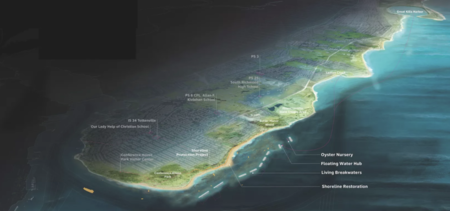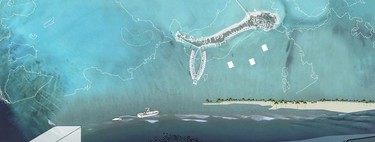New York has come up with a peculiar —and quite tasty— way to improve the health of its coasts and, above all, protect itself from major storms: eating oysters. Yes, a nice plate of bivalves with a squeeze of lemon and maybe a little Mignonette sauce. On the table they are a delicacy; but, once emptied, their shells can be reused to reinforce the seawalls and prevent the waves from lashing the city. It’s not as crazy as it seems. In the US they have already used oysters for a similar purpose in Louisiana and in the Big Apple they are collecting them with the help of hoteliers.
With the memory of Sandy still alive, the hurricane that hit the city in 2012 and left in its wake a trail of deaths and millionaire losses, the authorities of the Big Apple decided years ago to search for Ways to Strengthen Your Waterfront. One of the initiatives that was put on the table is Living Breakwaters, which wants to deploy a system of “living breakwaters” off the southern coast of Staten Island. Unlike conventional dams, the design incorporates a breakwater, which they hope to have ready in 2024, and an oyster bed, which will follow between 2023 and 2025.
An ally against the scourge of the waves
The aim is for the bivalves to reinforce the structure and make it even more resistant to the push of the waves. To achieve this, they are collecting shells in restaurants and preparing them to help in the breeding of new larvae. The Billion Oyster Project, founded in 2014 and which wants to promote biodiversity on one of the most dynamic coasts in the US, has turned to this task.
Living Breakwaters, in reality, does not seek anything other than to undo part of the man-made damage. Tottenville, for example, located on the southern tip of Staten Island and which suffered some of the most destructive waves to hit the region in 2012, originally enjoyed the natural shelter of oyster reefs. However, overexploitation, pollution, the accumulation of sediments and the dredging of the canals ended up erasing its effect.
“Currently, Raritan Bay is not only devoid of oysters, but also of the complex habitat its reefs provided and the richness of species and biodiversity they supported. Without these natural systems, the Staten Island shoreline remains exposed to the action of waves and coastal erosion and lacks this rich environmental resource”, point out those responsible. In addition to acting as a parapet against the waves, the program, they say, will help stop coastal erosion and increase the biodiversity and richness of New York Harbor’s marine habitats.

The “living breakwater” projected in New York.
The project wasn’t started just because of Sandy. As those responsible recognize, the call launched by the US authorities has its sights set on the effects of climate change. The Intergovernmental Panel on Climate Change has already warned about the risks faced by coastal regions in the 19th century from rising sea levels, and experts also predict an increase in extreme weather events. Another key factor is the coastal degradation. In some parts of Staten Island, erosion is advancing at three feet a year—close to a meter—making the area increasingly vulnerable.
How do you plan to act in New York? Living Breakwaters plans to build a system of about 730 linear meters of breakwaters and semi-submerged mounds between 240 and 550 meters from the coast. Furthermore, it contemplates replenishing sand in the areas most exposed to erosion and installing a floating oyster bed thanks to the work of Billion Oyster. “Techniques may include placing oyster hatchlings in some of the ecologically enhanced concrete units, installing oyster shell gabions (non-structural units), placing hatchlings on shells in reef streets, and installing pilots in situ”, they specify.
The problem It is not exclusive to the New York coast. Nor the solution that they have opted for in Staten Island. Without going any further, in Louisiana they have used bivalves to stop the erosion of their marshes, which have an important ecological and economic value and also act as a natural barrier against tidal waves and floods. In other parts of the country, such as Texas, the Chesapeke Bay or San Francisco, shell recycling programs have also been activated. Beyond the United States, cases are located in Australia or Bangladesh, where they are used with a very similar objective: to safeguard the island of Kutubdia against the rapid growth of the sea.
The challenge is global in scale. Apart from the fact that we may face high-impact storms like Sandy more frequently, experts are already warning that since the end of the 19th century the sea level has risen 20 centimeters and by the end of the 21st century it could rise even more than a meter.
Image André-Pierre du Plessis (Flickr)
George is Digismak’s reported cum editor with 13 years of experience in Journalism
